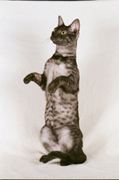
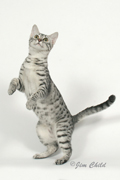
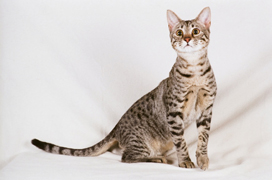



The only natural breed of spotted cat, the Egyptian Mau is an agile, strong cat with a beautifully spotted short coat. Unlike the spotted Bengal, the Mau is pure feline – it possesses no wildcat blood in its ancestry. What it does have is a long, fascinating history that may even go back to the time of the cat cult in ancient Egypt.
The Egyptian Mau dates back over 3000 years. The Egyptian Mau is possibly the oldest of all domestic cats and one of the naturally spotted breeds still in existence. The domestication of the Mau occurred sometime between 4000 and 2000 BC.
Egyptians very quickly saw the value of the Mau. They used them initially to hunt and retrieve birds. It is very common to see pictures of cats in marshes with birds in their mouths. The oldest images of cats in ancient Egypt are hieroglyphs carved on a temple wall around 2200 BC.
Around 2000 BC and on, the Mau started to hold a great importance in religion and was worshiped as a god. The Mau represented almost every aspect of their life. They were represented by over twenty some gods and goddess that were catlike figures.
Many cat cults, like the cult of Bastet, appeared during this time. They continued in to the Roman occupation around 330 AD. When a cat died in Egypt the body was mummified and entombed. The family of the deceased cat shaved their Eye brows as a sign of mourning. If a cat was ever harmed during this time it was an offense punishable by death.
One of the oldest breeds, the Egyptian Mau is thought to be the ancestor of the sacred cat worshiped by ancient Egyptians. As the story goes, during the time of the cat cult, Maus were worshiped as the physical manifestations of gods, and Egyptian women patterned their elaborate eye makeup after the Mau’s facial markings.
In Egypt, cats were first welcomed for their ability to keep rodents away from stores of grain, but later they became much more – first beloved household companions and then objects of worship.
Maus do not have the loud voices of the oriental breeds such as the Siamese, however some are quite talkative. They will often chirp rather than meow.
Most Maus do not have any unusual care requirements. As with any cat, a Mau will fair best if kept inside, fed a quality cat food and taken to the vet for shots and a thorough examination.
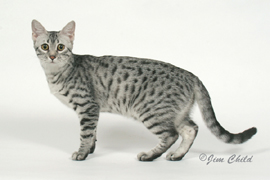
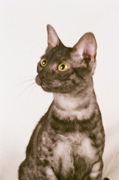
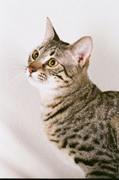
The spots will catch your eye, but the Mau’s personality will catch your heart. Maus are face kissers, toy chasers, shoulder perchers and, early in the morning, furry alarm clocks with cold noses and warm tongues. Fanciers describe Maus as fiercely loyal; they usually bond with one or two members of their human families and become devoted, loving, constant companions for as long as they live. Spending time with their preferred persons is their favorite activity, particularly if their favorite people would like to join in a game of fetch. Maus are the epitome of the curious, energetic, playful cat. Extremely active and intelligent, Maus require a good supply of toys, cat trees and other amusements or they will make toys out of your knickknacks. Feathered wands and toys with faux-fur or catnip are always popular. Actually, everything is a toy to the lively Mau, and they approach play with an intensity that is lacking in the more sedate breeds. Finding and bringing down prey mock and otherwise, is serious business to them. Maus actually keep track of their toys; if you put them away they’ll find out where they are and then drive you crazy demanding they be returned.
Like their alleged ancestors who tagged along on bird hunts, Maus stalk anything that moves. They love all hunting games, and particularly adore playing fetch. Toss a catnip mouse and your Mau will run it down, kill it and trot it back to you, eyes gleaming with predatory triumph. If allowed outside they usually become skillful hunters. For the sake of your Mau’s health and the well-being of local wildlife, however, it's best to keep your cat inside.
Maus aren’t overly talkative but they do make their desires known, particularly if those wishes involve food. When communicating with their favorite humans, Maus wiggle their tails, tread their feet, and many make a variety of musical chortling and trilling sounds rather than typical meows. However, their desire to vocalize and the sounds they make can vary greatly from cat to cat. Their unique tail wiggle can look like the tail movements of a spraying cat, but there’s no need to get out the cleanser because they do not actually spray while communicating in this way.
Maus love being up high so they can observe their domain in safety. Refrigerator vultures, Maus can be found peering down from the top, waiting for someone to open the door and, the great cat goddess willing, provide a tasty snack. Free-feeding can result in obese Maus; for this breed, measured meals are usually a better choice. Maus are keen observers and readily learn to open cabinets and doors. While Maus do fine as indoor-only cats, they hate closed doors, particularly when their favorite people, toys or treats are on the other side. Many Maus enjoy water (on their own terms, of course), but their enthusiasm also varies greatly from cat to cat. Some like to play in water but the majority of the Maus rather enjoy splashing their toes in water or drinking from the faucet. Kitty fountains that provide running water are a big hit with Maus.
The Egyptian Mau is the only breed that acquired its spots without human intervention, making this breed a pleasing package of natural beauty and action-packed personality. The body is medium long and graceful, showing well-developed strength. Boning is medium. Allowances are made for muscular necks and shoulders in adult males. A loose flap of skin extends from the flank to the knee of the hind leg. The legs are in proportion to the body, with the hind legs proportionately longer, giving the Mau the appearance of being on tip-toe when standing upright. The slightly oval feet are small and dainty. The tail is medium long, thick at the base, with a slight taper. Adult males weigh 10 to 14 pounds; adult females weigh 6 to 10 pounds. Balance is more important than size. No outcrosses are allowed.
The head is a slightly rounded wedge without flat planes, medium in length, without full cheeks. The profile shows a gentle contour with a slight rise from the bridge of the nose to the forehead. The entire length of the nose is even in width when viewed from the front. The muzzle, neither short nor pointed, flows into the wedge of the head. The chin is firm and not receding nor protruding.
The alert ears are medium to large, broad at the base, and moderately pointed. They continue the planes of the head and are slightly flared with ample width between the ears. The hair on the ears is short and closes lying, but the ears may have ear tufts. The inner ears are a delicate, almost transparent shell pink. The eyes are large, alert, and almond shaped, with a slight slant toward the ears. The skull openings around the eyes are neither round nor oriental. Eye color is a light green described as gooseberry green. An amber cast is acceptable in kittens and young cats up to 18 months.
The vivid, spotted coat is the Mau’s most striking feature. The hair is medium length with a lustrous sheen. Texture varies with coat color; cats with the smoke color have silky, fine hair, while silver and bronze cats have dense, resilient hair that accommodates two or more bands of ticking. However, the spotted pattern is always present regardless of color. The torso is randomly marked with spots that vary in size and shape. The spotting on each side of the torso need not match. The spots can be small or large, round, oblong or irregularly shaped, but must be distinct. There is good contrast between the pale ground color and the markings. The forehead is marked with the characteristic tabby M and frown marks, forming lines between the ears that continue down the back of the neck, ideally breaking into elongated spots along the spine. The tail is heavily banded and has a dark tip.
The cheeks are barred with mascara lines that start at the outer corner of the eye and continue along the contour of the cheek. A second line starts at the center of the cheek and curves upward, almost meeting the first line below the base of the ear. The upper chest has one or more broken necklaces. The shoulder markings make a transition between stripes and spots. The upper front legs are heavily barred but need not match. The haunches and upper hind legs make a transition between stripes and spots, breaking into bars on the lower leg. The underside of the body has vest buttons that are dark against the correspondingly pale ground color.
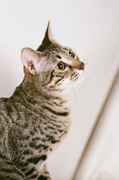

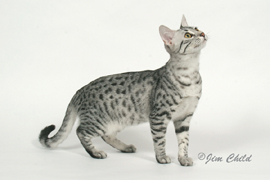
SILVER: pale silver ground color across the head, shoulders, outer legs, back, and tail. Underside fades to brilliant pale silver. All markings charcoal color with a white to pale silver undercoat, showing good contrast against lighter ground colors. Back of ears grayish-pink and tipped in black. Nose, lips, and eyes outlined in black. Upper throat area, chin, and around nostrils pale clear silver, appearing white. Nose leather: brick red. Paw pads: black with black between the toes and extending beyond the paws of the hind legs.
BRONZE: warm bronze ground color across head, shoulders, outer legs, back, and tail, being darkest on the saddle and lightening to a tawny-buff on the sides. Underside fades to a creamy ivory color. All markings are dark brown-black with a warm brown undercoat, showing good contrast against the lighter ground color. Back of ears tawny-pink and tipped in dark brown-black. Nose, lips, and eyes outlined in dark brown, with bridge of nose brown. Upper throat area, chin, and around nostrils pale creamy white. Nose leather: brick red. Paw pads: black or dark brown, with same color between toes and extending beyond the paws of the hind legs.
SMOKE: pale silver ground color across head, shoulders, legs, tail, and underside, with all hairs to be tipped in black. All markings jet black with a white to pale silver undercoat, with sufficient contrast against ground color for pattern to be plainly visible. Nose, lips, and eyes outlined in jet black. The upper throat area, chins, and around nostrils, is lightest in color. Nose leather: black. Paw pads: black with black between the toes and extending beyond the paws of the hind legs. Whiskers: black.
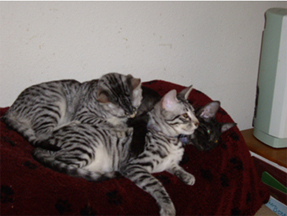
From our breeding and research center
If you would like to contact us:Cocoa@cocoaspride.com
Home (Home Index)
(Colette Griffiths)